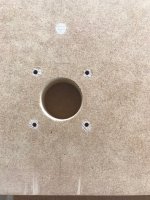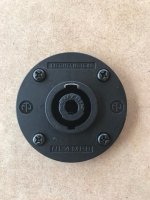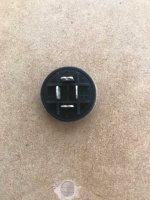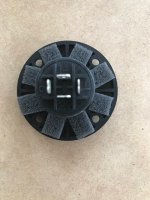There won't be anyone but me dealing with these so catering to the masses is not a considerationI understand Speakons have use in Pro audio for high power applications, but my opin is if some random person goes to hook up equipment and sees this, there will be a head scratching moment.
I have two types, I don't really like how the first set don't have the banana plug go all the way in and the second set are a little short so I will need to 'make' them fit.I would just go with 5-way binding posts myself.
As for drilling holes, I have found most "panel mount" accessories (especially from the 'shack) are meant for up to 1/8" (3mm) wall thickness. Some have threads that allow up to 1/4" (6mm). Just get a router and a 1/4" bit and set the depth such that the threaded portion of the part passes through to the other side, only far enough to allow secure connection. Then route around the hole until it's wide enough to accept the body of the part. That's how I connect hookups in thick panels anyhow.
Making either fit is no issue, I used speakons on my LX521 and buried the cable and connector in the panel. That was done on a split piece of wood with a cordless drill and a TCT router bit, so using a drill press on a flat panel is much easier.
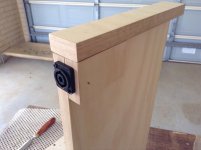
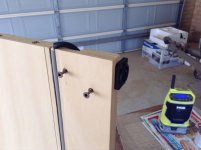
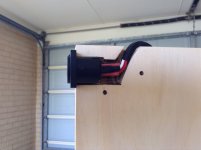
It just would have been easier to do before I glued the cabinet together.
I have another box of the gold plated type so that doesn't narrow down my choice!Of course, you have an entire box full of Speakon terminals, might as well use them up.
I'm leaning towards the speakons because it will make disassembly easier, I can pull the cable through the entry hole and remove the crimps outside the cabinet.
You are the one that can make the decision to keep yourself happy.
I'd say use whatever works best for you. Does that help?
About as much as a fortune cookie
if some random person goes to hook up equipment and sees this, there will be a head scratching moment.
Probably for all the wrong reasons...
I don't understand why expensive high end manufactures insist on using banana plugs while there is better available.
I have been temped on many occasions to fit Speakons in my Focal Eletra speakers. I'm sure that one day I wil actually do just that.
Let's face it, you're not going to be hot plugging cables while the amp is live, so shorts are not an issue unless you're careless with your hookups,
The issue is usually caused unintentional; example: you or your wife are cleaning with a mob and by accident the plugs are removed because someone tripped over a cable.
and a well designed modern amp will shut down or go into protect mode if this happens.
You would be surprised how many amps do not have short circuit protection!
My Sony amp has gone into protect mode exactly once in it's lifetime. 14awg unterminated stranded wire crammed into spring terminal. A single strand strayed from the flock and caused bigtime mischief! Works fine to this day...You would be surprised how many amps do not have short circuit protection!
Centre hole cut, mounting points have hardwood dowels glued in to the mdf to give more strength when screwing and unscrewing. You can see the other hole plugged to the top.
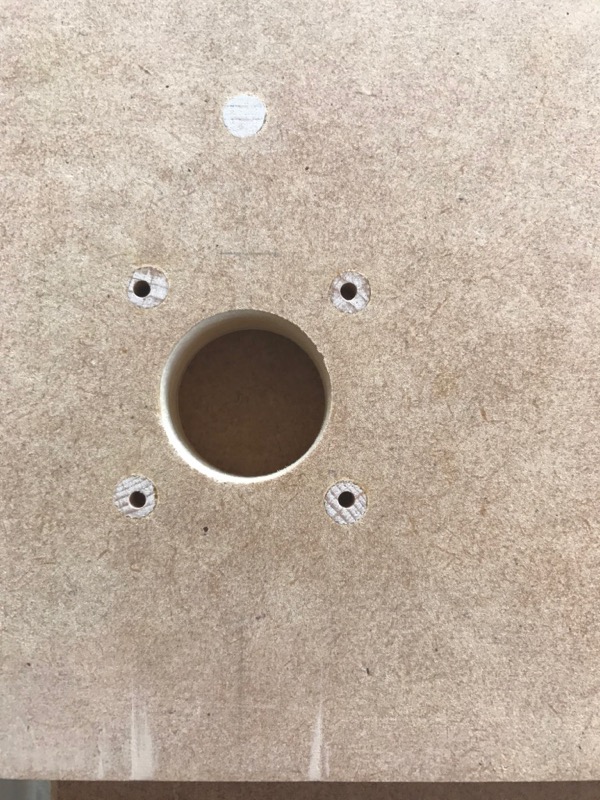
Connector attached
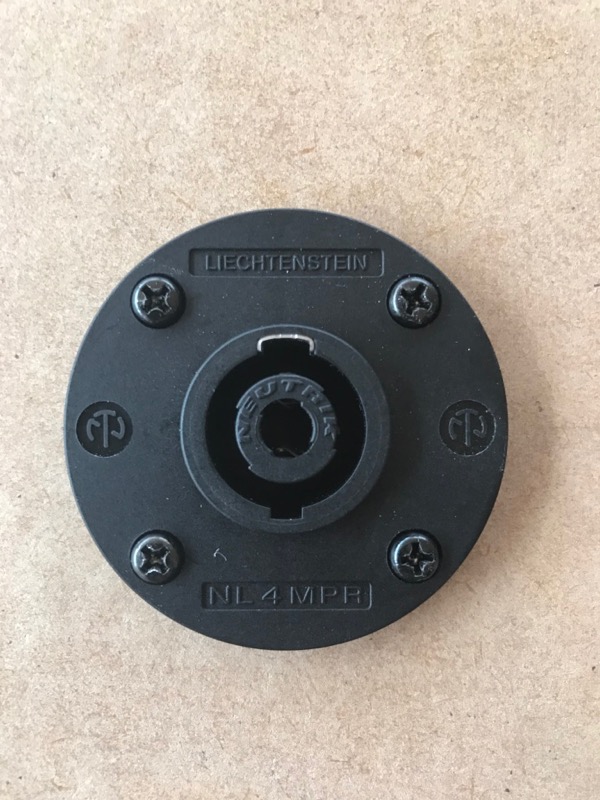
I used two wraps of insulation tape around the body to make it virtually a press fit without the screws.
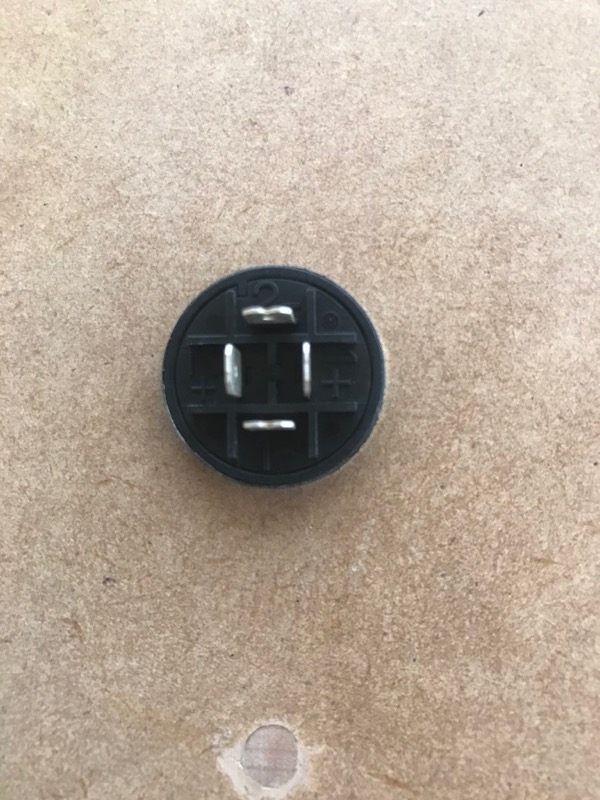
I put some bits of foam tape in the gaps at the back of the connector. Probably a waste of time but I had just the right amount of an off cut piece to do the job so why not..
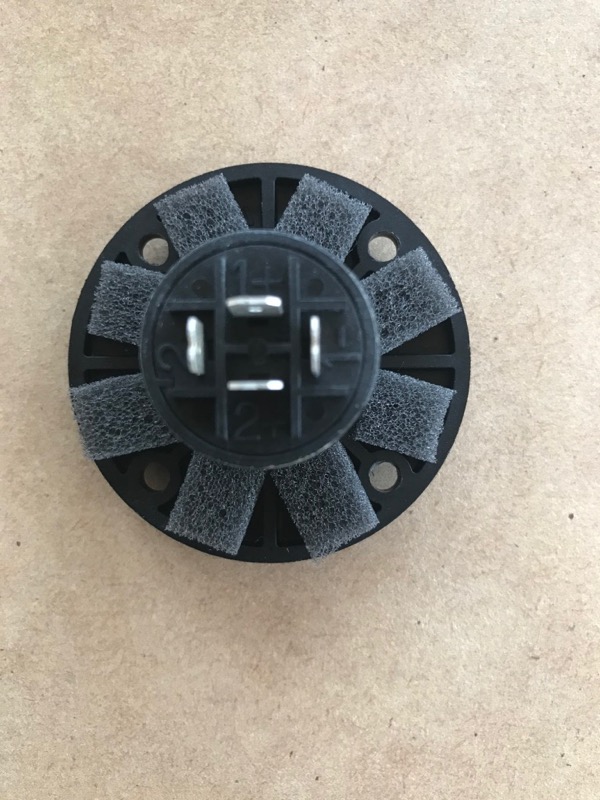
Connector attached
I used two wraps of insulation tape around the body to make it virtually a press fit without the screws.
I put some bits of foam tape in the gaps at the back of the connector. Probably a waste of time but I had just the right amount of an off cut piece to do the job so why not..
Attachments
Four connectors???
The version with two pins is more expensive to buy! It is exactly the same layout except 2+ and 2- are gone.
It can work as two pin or you can use 4 core wire and tie two together for double the cable thickness.
They are meant for two way systems which is how I normally use them but they work just fine for this.
Those look nice. Can't go wrong with Neutrik.
Tech details: NL4MPR - Neutrik
Silver plated bronze contacts, <3mOhm. That's gotta be better than zinc!
I also like these. Minimalist, pure copper gold plated connectors. No threads. About $60usd per set of 4 connectors. Relatively cheap compared to other pure copper posts. They will accept standard banana plugs.
Tech details: NL4MPR - Neutrik
Silver plated bronze contacts, <3mOhm. That's gotta be better than zinc!
I also like these. Minimalist, pure copper gold plated connectors. No threads. About $60usd per set of 4 connectors. Relatively cheap compared to other pure copper posts. They will accept standard banana plugs.
So you can bi-amp the speakers?They are meant for two way systems which is how I normally use them but they work just fine for this.
Those look nice. Can't go wrong with Neutrik.
Silver plated bronze contacts, <3mOhm. That's gotta be better than zinc!
Who knew they were so fancy
So you can bi-amp the speakers?
There's nothing to bi-amp, single way, full range all drivers wired together.
Yes and it will be totally swamped by the cable resistance in any case, nothing to worry about.Silver is more conductive than gold, but it tarnishes. That ~3mΩ will increase with age.
Sorry, I meant that they were intended for Bi-amping a pair of two way speakers with or without without passive crossovers, not necessarily for your full range line arrays.There's nothing to bi-amp, single way, full range all drivers wired together.
OT, but I always feel like removing the passive xovers from a two-way speaker for bi-amping would be risky. Sending full range to a tweet (due to misconfiguration or miswiring of an active crossover) could destroy the driver even at very low power.
Sorry, I meant that they were intended for Bi-amping a pair of two way speakers with or without without passive crossovers, not necessarily for your full range line arrays.
OT, but I always feel like removing the passive xovers from a two-way speaker for bi-amping would be risky. Sending full range to a tweet (due to misconfiguration or miswiring of an active crossover) could destroy the driver even at very low power.
The 4 pin Speakons can carry stereo or multi channel.
It's not really ment for bi-amping. B-amping does not exists in the pro world.
Sorry, I meant that they were intended for Bi-amping a pair of two way speakers with or without without passive crossovers, not necessarily for your full range line arrays.
OT, but I always feel like removing the passive xovers from a two-way speaker for bi-amping would be risky. Sending full range to a tweet (due to misconfiguration or miswiring of an active crossover) could destroy the driver even at very low power.
A 4 pin connector lends itself nicely to work with a 2 way active system but can be used for any application that requires 4 separate connections.
A 2 way active system is not bi-amping, different terminology. Bi-amping is leaving the passive crossover in place and feeding the two sections of that crossover from different amps, which I think is a very inefficient use of a pair of amps.
If you are worried about your tweeter or configuring things properly then use a protection capacitor. Major manufacturers use them for that reason or they make sure that the system cannot be misconfigured. Speakons can help with this as you can't insert them incorrectly (Just need to make sure you wire them properly in the first place).
To return to the topic of the thread I have started to glue up the second cabinet
- Home
- Loudspeakers
- Full Range
- Full Range TC9 Line Array CNC Cabinet
